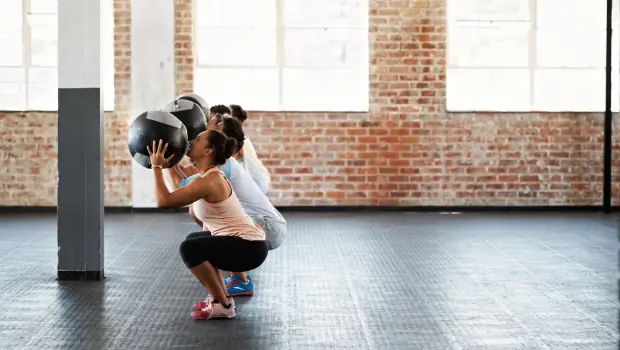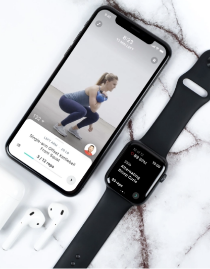
By clicking on the product links in this article, we may receive a commission fee at no cost to you, the reader. Sponsorships and affiliate commissions help support our research so we can help you find the best products. Read the full affiliate disclosure here.
After 10 seconds, I was gasping for breath, sweaty, and definitely convinced that four minutes of Tabata intervals counts as a real workout.
Greatist's Chief Research Officer David Tao was helping me "research" Tabata protocol, and after a round each of burpees, medicine ball clean and presses, and squats, I was feeling the burn (and then some, given how sore I was for the next three days).
Your FUTURE.CO coach personalizes your training plan, including tabata, to ensure you hit your goals:
What Is Tabata?
Tabata Protocol is a system of short, high-intensity intervals developed by Japanese professor Dr. Izumi Tabata to train Olympic speed skaters. Grab a stopwatch, because this workout method is all about timing.
The basic formula for a Tabata workout is 20 seconds of work followed by 10 seconds of rest, repeated between six and eight times (between three and four minutes, total). No cheating—the 20/10 ratio has been shown to work both aerobic and anaerobic metabolic pathways harder and more effectively than longer bouts of exercise.
The teeny-tiny intervals force the body to keep moving before it actually recovers from the previous set. So to get the full benefit, those 20 seconds need to be serious business—doing as many reps as possible is key.
Sometime between rounds six and eight the body reaches maximum oxygen intake, so prepare for trembling muscles and burning lungs. On the bright side, working the aerobic and anaerobic pathways fires up the "afterburn effect," so you'll be burning calories long after hitting the showers.
Tabata Workout
Because this exercise strategy is more of a formula than a specific workout, the possibilities for Tabata are pretty darn flexible. Love bodyweight exercises? Do a set of push-ups. Feeling a dip in the pool? Pull on that swim cap and do some freestyle intervals.
As with any workout regimen (and especially a high-intensity one like Tabata intervals), consult with a trainer beforehand to learn the correct technique. When going all-out, proper form can be the difference between a ticket to the gun show and a ticket to the physical therapist's office.
To make the journey from Tabata newbie to pro a bit easier, we called in the big guns: renowned trainers and Greatist Experts Ilen Bell and Kelvin Gary. Bell and Gary each picked one or two of the best moves for each area of the body, with added weights and using bodyweight alone. Each of these four-minute wonders packs a serious punch (just ask my quads after a round of squats), so start with just one or two exercises per Tabata workout.
Feel free to rest for a few minutes in between the 4-minute bouts, or go back-to-back for an added challenge.
Tabata Exercises
Full Body
1. Burpee: Start standing, then crouch to a low squat position with the hands on the floor. Then, kick feet back to a plank, then down into the bottom of a push-up. Push off the ground and quickly return to the squat position. Last step? Jump up as high as possible before squatting down again and jumping back into the next push-up.
Lower Body
2. Jump Squat: Stand with the feet hip-width apart, toes pointing forward. Sit back into a squat (hips below parallel, please!) then drive the whole body up through the heels, shifting weight onto the balls of the feet as you lift off. Be sure to land on the balls of the feet and immediately bend the knees into a full squat. Make sure the knees aren't wobbling side to side while squatting or landing from a jump.
3. Lunge Jump: Start standing with the feet together and lunge the right foot forward, bending the knee about 90-degrees and keeping the torso vertical. Then, jump straight up, and while in the air, switch legs and land in a lunge with the left foot forward.
4. Dumbbell Front Squat: Hold a dumbbell at the sternum (the center of the chest) and do a basic front squat. Place feet a little wider than shoulder-width apart, hips stacked over knees, knees over ankles. Inhale and unlock the hips, bringing them back as the knees begin to bend. Keep the chest and shoulders upright, and continue until the hips are slightly less than 90 degrees from the ground. On the way back up, engage the core and drive through the heels to return to standing.
5. Kettlebell Swing: Stand up straight, with feet a bit wider than hip-distance apart. Grab hold of the kettlebell with both hands, keeping the palms face down and arms in front of the body. Keep the knees slightly bent and drive the hips and bell back (it's not a squat, so the knees shouldn't have to bend that much), lowering the body just a bit to an athletic stance. In one fluid motion, explosively drive the hips forward while swinging the kettlebell, engaging the glutes and core.
Upper Body
6. Push-Up: Get into a plank position with hands planted a little bit wider than shoulder width apart. Keep the elbows close to the body throughout the movement. Ground the toes into the floor and engage the abs and back so the body is neutral. Lower the body in one straight line until the chest touches the floor. Keeping the core engaged, exhale, and push back to the start position.
7. Overhead Neutral Grip Press: Stand with the feet shoulder-width apart core tight. Raise the dumbbell, kettlebell, or barbell up to the shoulders with palms facing each other and the elbows below the wrists. Press the weights upward until the arms are fully extended overhead, and then lower back to the shoulders.
Cardio
8. Sprints: To get extra speedy, make sure form fits function. Hold the correct posture, with eyes up, chest tall, shoulders relaxed, and arms swinging up and down with the elbows at 45-degree angles.
9. Stationary Bike or Rower: Hopping on the bike for a quick spin is pretty self-explanatory, but the indoor rower is a bit trickier. First, strap feet into the foot stretchers, sit up tall, and grab the handle. Roll forward until legs are completely bent and arms are reaching forward.
From this starting position (called the "catch"), explosively drive the legs back. When the legs are nearly extended, swing the torso back and pull the arms in so the handle is almost touching the rib cage. From here (aka the "finish") recover by stretching the arms straight out, returning the upper body to a straight, vertical position, and bending the legs back to the catch.
Core
10. Russian Twist: Sit on the floor with the knees bent and feet together and lifted a few inches off the floor. With the back at a 45-degree angle from the ground, move the arms from one side to another in a twisting motion. Go super slow, twisting the shoulders completely from side to side.
11. Ski Abs: Start in a pushup position with hands under the shoulders and core engaged. Jump the feet to the left side of the body, as close to the upper torso as possible. Jump the legs back to a straight plank position and repeat on the right side.
With the exception of the weighted movements, most of these can be performed anywhere, any time. All you need is a set of comfy clothes and a serious work ethic. To make keeping track of the time easier, consider downloading a Tabata timer app. Again, consider meeting with a trainer to go over correct form (even if you've previously done these moves) before starting a Tabata fitness regimen to prevent injury.
Tabata FAQs
What is the difference between Tabata and HIIT?
Tabata exercises are completed at a higher intensity than HIIT because the increments are shooter. The recovery periods for Tabata workouts are also shorter, at only 10 seconds. HIIT workouts can have longer rest periods, up to two minutes.
What are the benefits of Tabata workouts?
Tabata elevates your heart rate quickly. These workouts limit rest, helping you keep your intensity up throughout the workout and allowing you to burn more calories in a short period of time.
What are the downsides of Tabata?
Tabata workouts are generally safe and super effective for weight-loss. However, due to their intensity, they may not be suitable for all fitness levels. They are also not recommended for heart patients or anyone with high blood pressure.
Connect with us on Twitter, Facebook, Instagram or Pinterest for more tips, recipes and ideas to fuel your ACTIVE life.
READ THIS NEXT: 15 Workout Milestones Every Fit Person Should Reach
 Stay in shape in a fitness class or read more fitness articles.
Stay in shape in a fitness class or read more fitness articles.



